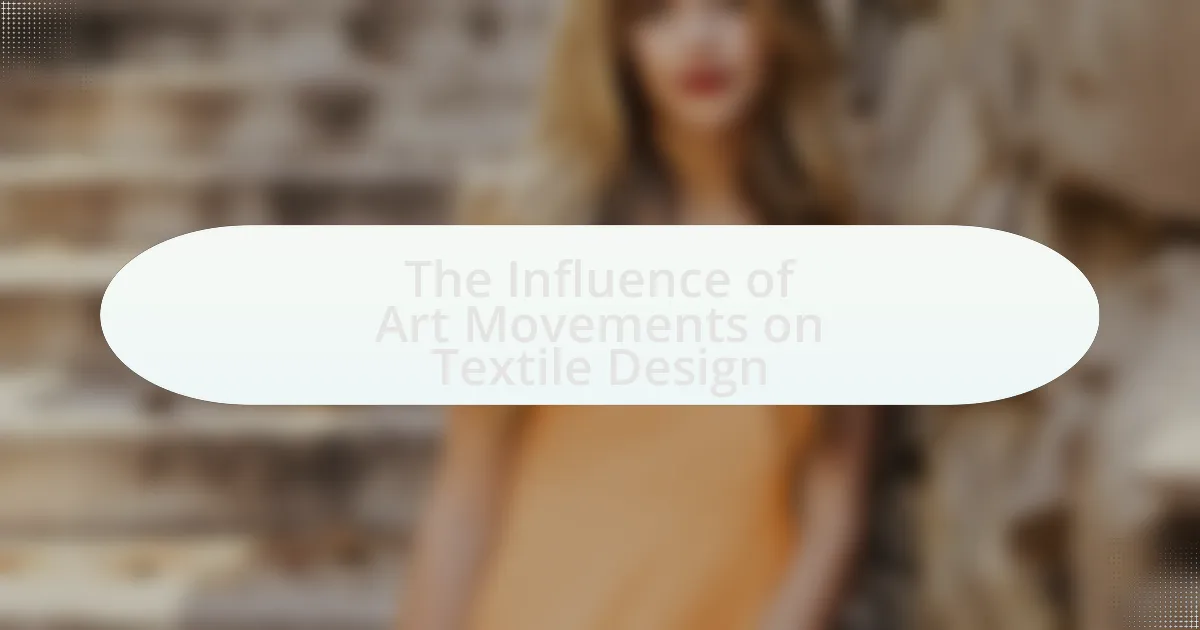The article examines the influence of various art movements on textile design, highlighting how these movements have introduced new aesthetics, techniques, and cultural narratives throughout history. Key movements discussed include the Arts and Crafts movement, which emphasized handcrafted textiles and natural materials, and the Bauhaus movement, known for its focus on functionality and geometric patterns. The article also explores how cultural contexts shape textile patterns and materials, the importance of understanding art movements for contemporary designers, and current trends that reflect historical influences. Additionally, it addresses the challenges designers face when referencing art movements and offers best practices for drawing inspiration from them.

What is the Influence of Art Movements on Textile Design?
Art movements significantly influence textile design by introducing new aesthetics, techniques, and cultural narratives. For instance, the Arts and Crafts movement emphasized handcrafted textiles, promoting natural materials and traditional craftsmanship, which led to a revival of artisanal textile production in the late 19th century. Similarly, the Bauhaus movement integrated modernist principles into textile design, focusing on functionality and geometric patterns, which transformed the approach to fabric design in the early 20th century. Additionally, the influence of Pop Art in the 1960s introduced bold colors and graphic imagery into textiles, reflecting contemporary culture and consumerism. These movements collectively shaped the evolution of textile design, demonstrating how artistic ideologies can redefine material culture and aesthetic values.
How have different art movements shaped textile design throughout history?
Different art movements have significantly shaped textile design throughout history by influencing patterns, techniques, and cultural themes. For instance, the Arts and Crafts Movement in the late 19th century emphasized handcrafted textiles with natural motifs, reflecting a reaction against industrialization. Similarly, the Bauhaus movement in the early 20th century introduced geometric patterns and functional designs, merging art with industrial production. The vibrant colors and abstract forms of the Abstract Expressionism movement also inspired textile designers to experiment with bold prints and textures. Each of these movements not only transformed aesthetic preferences but also reflected broader societal changes, such as the shift towards modernism and the embrace of individual creativity in design.
What are the key characteristics of major art movements that impact textile design?
Major art movements significantly influence textile design through their distinct characteristics, such as color palettes, patterns, and thematic elements. For instance, the Arts and Crafts movement emphasized handcrafted quality and natural motifs, leading to textiles that featured organic patterns and earthy colors. In contrast, the Bauhaus movement introduced geometric shapes and a focus on functionality, resulting in textiles that utilized bold colors and simple forms. Additionally, the Surrealist movement inspired textiles with dreamlike imagery and unexpected combinations, pushing the boundaries of traditional design. Each of these movements has left a lasting impact on textile design, shaping aesthetic trends and production techniques throughout history.
How do cultural contexts of art movements influence textile patterns and materials?
Cultural contexts of art movements significantly influence textile patterns and materials by reflecting the values, aesthetics, and technologies of their time. For instance, the Arts and Crafts movement in the late 19th century emphasized handmade textiles, showcasing natural dyes and organic patterns that echoed a reaction against industrialization. This movement’s focus on craftsmanship and simplicity led to the use of materials like linen and wool, which were readily available and aligned with its ethos. Similarly, the Bauhaus movement in the early 20th century promoted functionalism and geometric designs, resulting in textiles that utilized synthetic fibers and bold patterns, reflecting the modernist ideals of efficiency and innovation. These examples illustrate how the cultural narratives and technological advancements of specific art movements directly shape the characteristics of textile design.
Why is understanding art movements important for textile designers?
Understanding art movements is crucial for textile designers because it informs their creative process and enhances their ability to innovate. By studying various art movements, designers gain insights into historical contexts, aesthetic principles, and cultural influences that shape design trends. For instance, the Arts and Crafts movement emphasized handcrafted quality and natural materials, which can inspire contemporary textile designs that prioritize sustainability and craftsmanship. Additionally, knowledge of movements like Bauhaus or Art Deco can guide designers in incorporating geometric patterns and bold colors into their work, aligning with modern consumer preferences. This understanding not only enriches a designer’s portfolio but also allows them to create textiles that resonate with specific artistic narratives, ultimately leading to more meaningful and marketable products.
How can knowledge of art movements enhance creativity in textile design?
Knowledge of art movements enhances creativity in textile design by providing designers with a rich historical context and diverse visual language. Understanding movements such as Bauhaus, Art Deco, or Impressionism allows textile designers to draw inspiration from established aesthetics, techniques, and philosophies. For instance, the Bauhaus movement emphasized functional design and simplicity, which can lead to innovative textile patterns that prioritize usability alongside aesthetics. Additionally, familiarity with color theory and composition from movements like Impressionism can inspire unique color palettes and textures in fabric design. This knowledge not only broadens a designer’s creative toolkit but also encourages experimentation and the fusion of styles, ultimately leading to more original and impactful textile creations.
What role do art movements play in the evolution of textile design trends?
Art movements significantly influence the evolution of textile design trends by introducing new aesthetics, techniques, and cultural narratives. For instance, the Arts and Crafts movement in the late 19th century emphasized handcrafted textiles and natural materials, which led to a resurgence of traditional weaving techniques and patterns. Similarly, the Bauhaus movement in the early 20th century integrated industrial processes with artistic design, resulting in functional textiles characterized by geometric patterns and bold colors. These movements not only shaped the visual language of textiles but also reflected broader societal changes, such as the shift towards modernism and sustainability. Thus, art movements serve as catalysts for innovation in textile design, impacting both the artistic direction and the production methods used in the industry.

Which Art Movements Have Significantly Influenced Textile Design?
Several art movements have significantly influenced textile design, including Arts and Crafts, Art Nouveau, Bauhaus, and Modernism. The Arts and Crafts movement, which emerged in the late 19th century, emphasized handcrafted textiles and natural materials, promoting a return to traditional craftsmanship. Art Nouveau, popular in the late 19th and early 20th centuries, introduced organic forms and intricate patterns, which became prominent in fabric designs. The Bauhaus movement, active in the early 20th century, focused on functionalism and simplicity, leading to innovative textile techniques and designs that integrated art with industrial production. Modernism further pushed boundaries by embracing abstraction and minimalism, influencing contemporary textile patterns and materials. Each of these movements contributed distinct philosophies and aesthetics that shaped the evolution of textile design.
What are the defining features of the Arts and Crafts Movement in textile design?
The defining features of the Arts and Crafts Movement in textile design include a focus on handcrafted techniques, natural materials, and a strong emphasis on simplicity and functionality. This movement, which emerged in the late 19th century, sought to counteract the industrialization of textile production by promoting artisanal methods and the use of organic fibers such as cotton, linen, and wool. Designers like William Morris championed intricate patterns inspired by nature, emphasizing the importance of aesthetics in everyday objects. The movement also advocated for the integration of art into daily life, leading to textiles that were not only practical but also visually appealing, reflecting a commitment to craftsmanship and quality.
How did the Arts and Crafts Movement promote craftsmanship in textiles?
The Arts and Crafts Movement promoted craftsmanship in textiles by emphasizing handmade production and the value of traditional techniques. This movement, which emerged in the late 19th century, rejected industrial mass production and instead celebrated the skills of artisans. Key figures like William Morris advocated for the integration of art into everyday life, encouraging the use of natural materials and intricate designs that reflected the craftsmanship of the maker. The movement’s focus on quality over quantity led to a revival of textile arts, with an emphasis on unique, handcrafted pieces that showcased individual creativity and skill.
What impact did the Arts and Crafts Movement have on modern textile aesthetics?
The Arts and Crafts Movement significantly influenced modern textile aesthetics by promoting handcrafted techniques and natural materials. This movement, which emerged in the late 19th century, emphasized the value of artisanal craftsmanship over industrial production, leading to a resurgence of interest in textiles that feature intricate patterns and organic forms. Designers such as William Morris advocated for the use of natural dyes and motifs inspired by nature, which are now foundational elements in contemporary textile design. The emphasis on sustainability and the rejection of mass production in the Arts and Crafts Movement laid the groundwork for modern eco-friendly textile practices, reinforcing the importance of quality and individuality in textile aesthetics today.
How did the Bauhaus movement revolutionize textile design?
The Bauhaus movement revolutionized textile design by integrating art, craft, and technology, emphasizing functionalism and simplicity. This approach led to innovative techniques and materials, such as the use of synthetic fibers and experimental weaving methods. Notably, designers like Anni Albers and Gunta Stölzl created textiles that combined aesthetic appeal with practical use, reflecting the Bauhaus philosophy of merging form and function. The movement’s focus on geometric patterns and bold colors also influenced modern textile aesthetics, establishing a foundation for contemporary design practices.
What principles of the Bauhaus movement are evident in contemporary textiles?
The principles of the Bauhaus movement evident in contemporary textiles include functionality, simplicity, and the integration of art and technology. Contemporary textile designers often prioritize functional design, reflecting the Bauhaus belief that form should follow function, which is evident in the use of durable materials and practical applications in modern fabrics. Additionally, the emphasis on simplicity and minimalism in Bauhaus aesthetics is mirrored in contemporary textiles through clean lines and geometric patterns. The fusion of art and technology, a core tenet of the Bauhaus, is also present in contemporary textiles, as designers utilize advanced manufacturing techniques and digital printing to create innovative designs that maintain artistic integrity. This alignment with Bauhaus principles demonstrates the lasting impact of the movement on modern textile design.
How did the Bauhaus approach to design influence textile production techniques?
The Bauhaus approach to design significantly influenced textile production techniques by emphasizing functionality, simplicity, and the integration of art and technology. This movement encouraged the use of industrial materials and methods, leading to innovative weaving techniques and the adoption of machine production in textiles. For instance, Bauhaus designers like Anni Albers explored the relationship between traditional craftsmanship and modern technology, resulting in textiles that combined aesthetic appeal with practical use. The Bauhaus also promoted the idea of design as a collaborative process, which fostered interdisciplinary approaches that enhanced textile production efficiency and creativity.

How Do Art Movements Affect Contemporary Textile Design Practices?
Art movements significantly influence contemporary textile design practices by providing aesthetic frameworks and conceptual inspirations. For instance, the Bauhaus movement emphasized functionality and simplicity, which has led to the integration of minimalist designs in modern textiles. Additionally, the Arts and Crafts movement’s focus on handcrafted quality has inspired a resurgence in artisanal textile production, promoting sustainable practices. The impact of these movements is evident in the use of bold colors and geometric patterns derived from Pop Art, which are prevalent in current textile collections. Historical context shows that designers often reference these movements to create innovative textiles that resonate with contemporary cultural narratives.
What current trends in textile design are influenced by historical art movements?
Current trends in textile design are significantly influenced by historical art movements such as Art Deco, Bauhaus, and Abstract Expressionism. For instance, the geometric patterns and bold colors of Art Deco have resurfaced in contemporary fabrics, reflecting a revival of luxury and elegance. Similarly, Bauhaus principles emphasizing functionality and simplicity are evident in minimalist textile designs that prioritize clean lines and practical use. Abstract Expressionism’s focus on spontaneity and emotion has inspired designers to create textiles that feature expressive brush strokes and vibrant color palettes, allowing for a more personal and artistic touch in modern interiors. These influences demonstrate how historical art movements continue to shape and inspire current textile design trends.
How are designers integrating elements from past art movements into modern textiles?
Designers are integrating elements from past art movements into modern textiles by incorporating distinctive patterns, color palettes, and techniques that reflect historical styles. For instance, the use of Art Deco geometric patterns and bold colors is prevalent in contemporary fabric designs, showcasing a revival of the elegance associated with the 1920s. Additionally, designers often draw inspiration from the organic forms and natural motifs of the Arts and Crafts movement, which emphasizes craftsmanship and quality materials. This integration not only pays homage to historical aesthetics but also adapts them to current trends, creating textiles that resonate with both nostalgia and modernity.
What challenges do contemporary textile designers face when referencing art movements?
Contemporary textile designers face significant challenges when referencing art movements, primarily due to the need for originality while navigating historical context. Designers must balance the influence of established art movements, such as Bauhaus or Art Deco, with the expectation of creating innovative and unique designs that do not merely replicate past styles. This challenge is compounded by the risk of cultural appropriation, where designers may unintentionally borrow elements from cultures without proper understanding or respect, leading to ethical concerns. Additionally, the rapid pace of fashion trends requires designers to adapt and reinterpret art movements quickly, which can dilute the original intent and meaning behind those movements. The complexity of these factors illustrates the intricate relationship between textile design and art history, necessitating a thoughtful approach to referencing past influences.
What are some best practices for textile designers to draw inspiration from art movements?
Textile designers can effectively draw inspiration from art movements by studying the historical context, techniques, and visual elements of those movements. Engaging with primary sources, such as artworks and artist statements, allows designers to understand the underlying philosophies and aesthetics that define each movement. For instance, the bold colors and geometric patterns of the Bauhaus movement can inspire modern textile designs that emphasize functionality and simplicity. Additionally, attending exhibitions and art fairs provides firsthand exposure to contemporary interpretations of historical styles, fostering innovative design ideas. Researching the impact of specific art movements, such as Impressionism’s focus on light and color, can also guide textile designers in creating fabrics that evoke similar emotional responses.
How can textile designers effectively research and apply art movement influences?
Textile designers can effectively research and apply art movement influences by studying historical contexts, analyzing key characteristics of specific movements, and experimenting with techniques and materials associated with those movements. For instance, designers can explore the color palettes, patterns, and textures prevalent in movements like Art Deco or Bauhaus, which emphasize geometric forms and bold colors. By visiting museums, reading scholarly articles, and engaging with contemporary artists, designers gain insights into the philosophies and aesthetics that define these movements. Additionally, practical application can involve creating textile samples that reflect these influences, allowing designers to innovate while paying homage to historical styles. This approach is validated by the fact that many successful textile collections draw inspiration from art movements, demonstrating the relevance of historical context in contemporary design practices.
What resources are available for textile designers to explore art movements?
Textile designers can explore art movements through various resources, including books, online courses, museums, and digital archives. Books such as “Textiles and Fashion: Materials, Processes and Products” by Rose Sinclair provide historical context and analysis of art movements in relation to textile design. Online platforms like Coursera and Skillshare offer courses on art history that specifically address the influence of different movements on design practices. Museums, such as the Victoria and Albert Museum in London, house extensive textile collections that reflect various art movements, allowing designers to study original works. Additionally, digital archives like the Textile Museum’s online collection provide access to a wide range of textile samples and historical references, facilitating deeper understanding of the interplay between art movements and textile design.

Leave a Reply